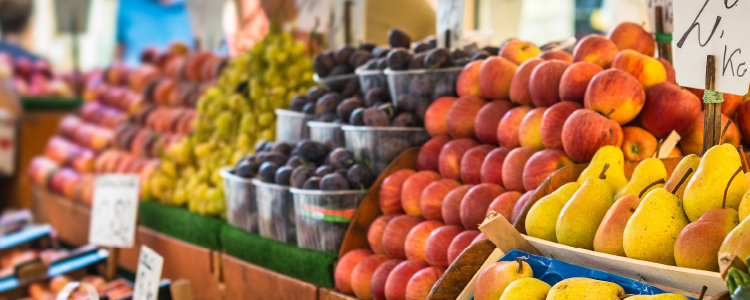


Sign-up for {N}power to get exclusive discounts, newsletters, members-only features, and more!


Spring is nearly here, with summer on its heels, and soon most of the country will be celebrating the return of fresh seasonal produce. But with this influx of fresh-off-the-vine tomatoes and peaches picked at their peak of perfection comes a debate: local or organic? Which is more important? The simple answer to this question is both. But the fact of the matter is, the two don’t always go hand in hand, and unfortunately we’re often faced with making a decision between the two. So when you are forced to choose one, which will have the greater positive environmental impact: local or organic? Spoiler alert: it’s organic.
A poll conducted in 2014 found that 23% of US and Canadian consumers falsely believed that local food is grown organically, and 17% mistakenly believed the term organic also meant local.[fn value=1][/fn] So let’s just make sure everyone is on the same page with these terms. Organic agriculture is a system of farming that prohibits the use of synthetic pesticides, fertilizers, hormones and antibiotics, as well as genetically modified organisms. “Certified organic” communicates to the consumer that the food was grown with these strict standards and that the farm was inspected by an independent, third-party certifier. In short, organic sets standards and ensures they are enforced so consumers know what they are getting every time. Local food is much more loosely defined, lacks formal standards, and generally refers to the distance a food has traveled from the farm to the consumer, a.k.a. its “food miles.” Some people define the term local to mean food grown in their immediate area, state, or region, while others may choose to define local as a 100- to 400-mile radius, or a one-day drive. Local aims to make a positive environmental impact by reducing the distance food travels, while organic aims to make a positive impact by reducing the chemicals put into the environment and fostering soil health and biodiversity. Both are worthy goals and both are in stark contrast to our conventional global food system.
Tracking the environmental impact of food miles is more complicated than most people realize. The true impact of food miles depends on several factors, including whether the item is made of a single ingredient or multiple ingredients (a fresh apple vs. an apple pie), the mode of transportation used, the suitability of the climate a particular food was grown in, and the distance a consumer travels to buy the food. While it is true that local foods do tend to reduce the fuel consumed and the carbon dioxide (CO2) released from burning that fuel, there are exceptions. For instance, food traveling a short distance by road may produce more CO2 than the same food traveling a longer distance by water or rail.[fn value=2][/fn] In some cases, depending on the food and climate, reducing food miles doesn’t actually reduce energy consumption. For example, it was found to be less energy intensive to grow tomatoes in Spain and ship them to Sweden than it was to grow the tomatoes in Sweden because of the large amount of energy used to heat the greenhouses required to grow tomatoes in Sweden.[fn value=3][/fn] While watching food miles and buying local can certainly be of value in decreasing the carbon footprint of our food, it alone isn’t a reliable indicator of a food’s environmental cost.
Of the total amount of fossil fuel used in the US food system, about 14% is used for transport.[fn value=4][/fn] While not an insignificant number, researchers estimate that between 6 and 40% of the fossil fuels used in the food system goes to production of synthetic fertilizers and pesticides (which includes herbicides and fungicides).[fn value=5][/fn] [fn value=6][/fn]
Conventional farming relies heavily on synthetic fertilizers and pesticides. Not only are these chemical inputs created from fossil fuels, but they also require a lot of fossil fuels in the production steps.[fn value=7][/fn] Organic agriculture strictly prohibits the use of such chemicals and, consequently, doesn’t have the same high energy demands as conventional agriculture. In fact, on average, organic crops use 30% less energy than conventional crops and most of this difference is attributed to the chemical fertilizers and pesticides.[fn value=8][/fn]
And the cost of chemical inputs doesn’t end with the use of fossil fuels. The chemicals used in conventional agriculture are one of the leading causes of river and lake pollution in the US and contribute to eutrophication, disrupting ecosystems and interfering with the health and diversity of fish and animal populations.[fn value=9][/fn] They are also likely one of the main culprits in bee colony collapse disorder, and then there are the very serious effects on human health.
Through organic agriculture’s strict standards, not only does it use less fossil fuel, therefore contributing less pollution to the atmosphere, it actually helps to reduce the amount that is already there. Organic agriculture’s real environmental pièce de résistance is that it fosters healthy soil, and healthy soil removes CO2 from the atmosphere! One study found that organic soils were able to sequester between 15 and 28% more CO2 than their conventional counterparts.[fn value=10][/fn] Reducing CO2, all while protecting the water, air, and life on the planet. Wow! Organic just knocked local out of the park.
So this spring as you enjoy the return of fresh, seasonal produce, if available, local and organic is your best choice, but when you have to choose between the two, remember that all of the positive impacts organic has on the environment easily makes it the best choice.



Sign-up for {N}power to get exclusive discounts, newsletters, members-only features, and more!